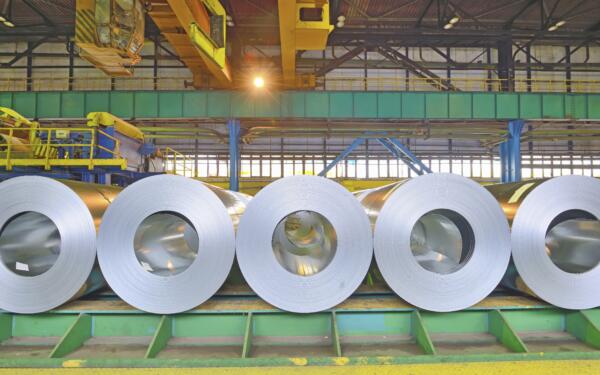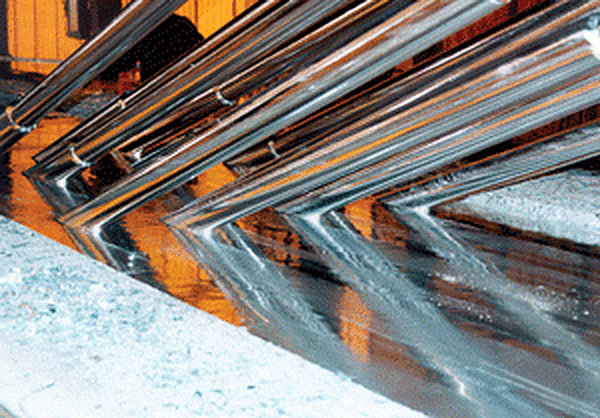Continuous Sheet Galvanizing ASTM A653 (G60, G90) vs. Batch Hot-dip Galvanizing ASTM A123

Note: Have questions about continuous hot-dip galvanizing? Contact the GalvInfo Center
Continuous hot-dip galvanizing and after-fabrication batch hot-dip galvanizing are often confused because they are both hot-dip galvanized products. Though similar, these two methods of hot-dip galvanizing differ in terms of application process, available product that can be coated, and coating thickness.
The continuous hot-dip coating process according to ASTM A653, Specification for Steel Sheet, Zinc-Coated (Galvanized) or Zinc-Iron Alloy-Coated (Galvannealed) by the Hot-Dip Process, is a widely used method to coat sheet products prior to fabrication. In this process, steel is passed as a continuous ribbon through production and into a bath of molten zinc at speeds up to 600 feet per minute. Once the product is removed from the bath, high-pressure air is used to remove any excess molten zinc to create a closely controlled coating thickness. Afterward, the steel is cooled and rolled into large coils for eventual fabrication. Today, the continuous sheet process is used to make seven different types of hot-dip coated products, including galvanized (zinc), galvannealed (90-92% zinc / 8-10% iron alloy), two alloys of zinc and aluminum (55% aluminum / 45% zinc alloy and 95% zinc / 5% aluminum alloy), two aluminum based alloys (100% aluminum, 89-95% aluminum / 5-11% silicon alloy), and the terne coating (85-97% lead / 3-15% tin alloy).
Batch hot-dip galvanizing according to ASTM A123, Specification for Zinc (Hot-Dip Galvanized) Coatings on Iron and Steel Products, refers to the process where steel articles are suspended by chain, hook, or wire, and then coated by immersing the articles in a kettle containing molten zinc. This method is suitable for products to be galvanized after-fabrication such as plate, poles, beams, frames, trailers and other assemblies.
Both galvanized products provide barrier and cathodic protection, but have applications where they are best utilized. If you are simply trying to specify a hot-dip galvanized coating weight that is anywhere from 0.3 - 3.6 oz/ft2, this can be achieved using either process. However, if the steel is very thin (less than 7 gauge), warpage/distortion is a possibility with the batch process. Furthermore, if it is required to form the steel into various shapes after hot-dip galvanizing, then continuous galvanizing is preferred because it is very formable without cracking the galvanized coating. This is because the coating formed by the continuous process is made almost entirely of eta layer (free zinc) and has very little alloying unlike the hot-dip galvanized coatings produced using the batch process. This lack of alloying also means pre-galvanized sheet is less abrasion resistant than steel galvanized using the batch process.

There are also significant differences between coating thickness and longevity. ASTM A123 requires a minimum average coating thickness based on material category and steel thickness and has no maximum value for coating thickness. Meanwhile, continuous sheet galvanizing per ASTM A563 contains a list of zinc coating thickness designations such as G30, G60, and G90. To clarify, G30/G60/G90 are not a galvanizing specifications; they are coating thickness designations found in the continuous galvanizing specification ASTM A653 that refer to a dual-sided coating weight in oz/ft2. These coating weight values must be divided by two to provide an approximate comparison to the single-sided coating thickness values provided in ASTM A123. Refer to Tables 1 & 2 below to compare some of the common coating thickness values achieved using each process (refer to each specification for a full list of coating grades).
TABLE 1: CONTINUOUS GALVANIZING (PRE-GALVANIZED SHEET PRODUCTS 7 GAUGE [3/16"] TO 32 GAUGE [0.102"] THICK), MINIMUM AVERAGE COATING THICKNESS [MILS]
Coating Grade ASTM A653 | Coating Weight (Total Both Sides) | Equivalent Coating Thickness (one side) |
|---|---|---|
| G30 | 0.30 oz/ft2 | 0.26 mils |
| G60 | 0.60 oz/ft2 | 0.51 mils |
| G90 | 0.90 oz/ft2 | 0.77 mils |
| G115 | 1.15 oz/ft2 | 0.98 mils |
| G140 | 1.40 oz/ft2 | 1.20 mils |
| G165 | 1.65 oz/ft2 | 1.40 mils |
| G185 | 1.85 oz/ft2 | 1.57 mils |
| G210 | 2.10 oz/ft2 | 1.79 mils |
| G235 | 2.35 oz/ft2 | 2.00 mils |
| G300 | 3.00 oz/ft2 | 2.55 mils |
| G360 | 3.60 oz/ft2 | 3.06 mils |
TABLE 2: BATCH HOT-DIP GALVANIZING (AFTER-FABRICATION), MINIMUM AVERAGE COATING THICKNESS [MILS]
| Steel Thickness | ||||||
|---|---|---|---|---|---|---|
| Material Category ASTM A123 | <1/16 [5<1.6] | >1/16 to <1/8 [>1.6 to <3.2] | >1/8 to <3/16 [>3.2 to < 4.8] | >3/16 to <1/4 [>4.8 to <6.4] | >1/4 to <5/8 [>6.4 to <16.0] | >5/8 [>16.0] |
| Structural Shapes | 1.8 mils | 2.6 mils | 3.0 mils | 3.0 mils | 3.9 mils | 3.9 mils |
| Plate | 1.8 mils | 2.6 mils | 3.0 mils | 3.0 mils | 3.0 mils | 3.9 mils |
| Pipe & Tubing | 1.8 mils | 1.8 mils | 3.0 mils | 3.0 mils | 3.0 mils | 3.0 mils |
The most commonly encountered coating thickness designations for continuous hot-dip galvanized products (G30, G60, and G90) are significantly thinner than those achieved though batch hot-dip galvanizing. Since coating thickness is directly related to service life, greater longevity is achieved when specifying batch hot-dip galvanizing. Generally, a hot-dip galvanized coating thickness of at least 3.0 mils is recommended for long-term corrosion protection in exterior environments or contact with soil (for example, solar infrastructure commonly considers both coating options). For interior or mild environments (ductwork, appliances, etc.) continuous hot-dip galvanizing is likely to provide suitable longevity.
If you are looking for more information about the use and performance of continuous sheet galvanized products, please contact the GalvInfo Center.
See Also:
© 2025 American Galvanizers Association. The material provided herein has been developed to provide accurate and authoritative information about after-fabrication hot-dip galvanized steel. This material provides general information only and is not intended as a substitute for competent professional examination and verification as to suitability and applicability. The information provided herein is not intended as a representation or warranty on the part of the AGA. Anyone making use of this information assumes all liability arising from such use.

